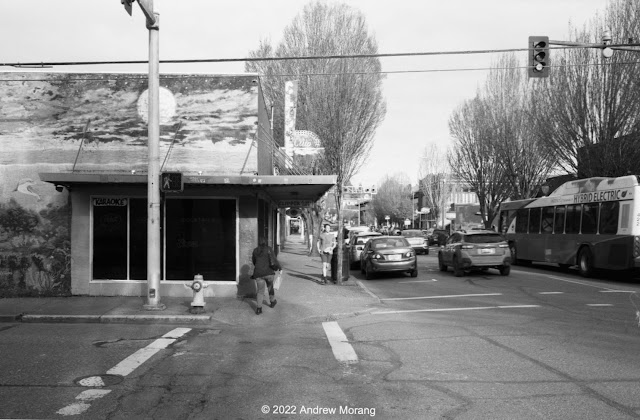The Olympic Peninsula is a fabulous terrain of mountains, temperate rain forest, lakes, and lonely beaches. The Olympic Mountains dominate the core of the peninsula. In a previous life, I hiked in the Olympics, climbed Mount Olympus, and camped along the rugged Pacific shore. I revisited in early 2022 but only had time for casual day trips.
 |
| Rain forest near Lake Quinault |
First of all is the incredible rain forest. It overwhelms with giant trees, moss, ferns, and lushness. These lush forests are among the limited remaining primeval temperate rain forest in the lower 48 states. Rainfall ranges from 140 to 167 inches per year (in contrast, Vicksburg, Mississippi, receives around 57 inches and Athens, Greece, receives only 14.9 inches). We saw the unusual American dipper in one of these ponds. This little bird bobs up and down and walks along the bottom of ponds.
 |
| Kestner-Higley Homestead, Lake Quinault, Olympic Peninsula (Gold 200 film, Kodak Retina IIa camera, 50mm ƒ/2 Xenon lens) |
 |
| Chevrolet truck, Kestner-Higley Homestead |
 |
| Chevrolet truck |
 |
| Chevrolet truck taken on Fuji Acros film, Leica M2, 35mm ƒ/2 Summicron lens |
The Kestner-Higley Homestead is at the northeast corner of Lake Quinault. The short circle trail is an easy and fun walk.
 |
| Pottery studio, Hoquiam (Gold 200 film, 1/100 ƒ/8) |
This little 1930s grocery store is now a pottery studio. It is on East Hoquiam Road seemingly a long way from any towns.
 |
| Lincoln Street Grocery, Hoquiam (Gold 200 film, 1/100 ƒ/8) |
Heading south on US 101, you reach
Hoquiam. This former lumber town is on the north shore of Greys Harbor. The town is a bit rough and will offer some interesting photo subjects in the future.
 |
| Seat with a view, 121 Park Avenue, Aberdeen (Gold 200 film, 1/100 ƒ/5.6½) |
 |
| Wishkah River at junction with Chehalis River, Aberdeen (1/100 ƒ/5.6) |
Aberdeen is more than a bit rough. I need to return and look around for more photo opportunities. The city is at the mouth of the Chehalis River where it debouches into Greys Harbor. The city thrived as a lumber port during the early 20th century because Greys Harbor was ice-free. The lumber could be shipped south along the Pacific coast to markets in California and Asia. But most of the mills closed in the 1970s and 1980s, and the town went through rough times.
We ate at Duffy's Restaurant and had excellent smelts. Smelts are little salt water fish that are usually fried. In a previous life, the famous Durgin Park Restaurant in Boston served smelts. But once they dropped smelts (and mackerel!) from the menu, I knew the end was coming.
This ends our all-to-short tour of the Olympics. Most of the photographs are from Kodak Gold 200 film that I exposed in my little Kodak Retina IIa camera. I scanned the film with a Plustek 7600i film scanner.










































